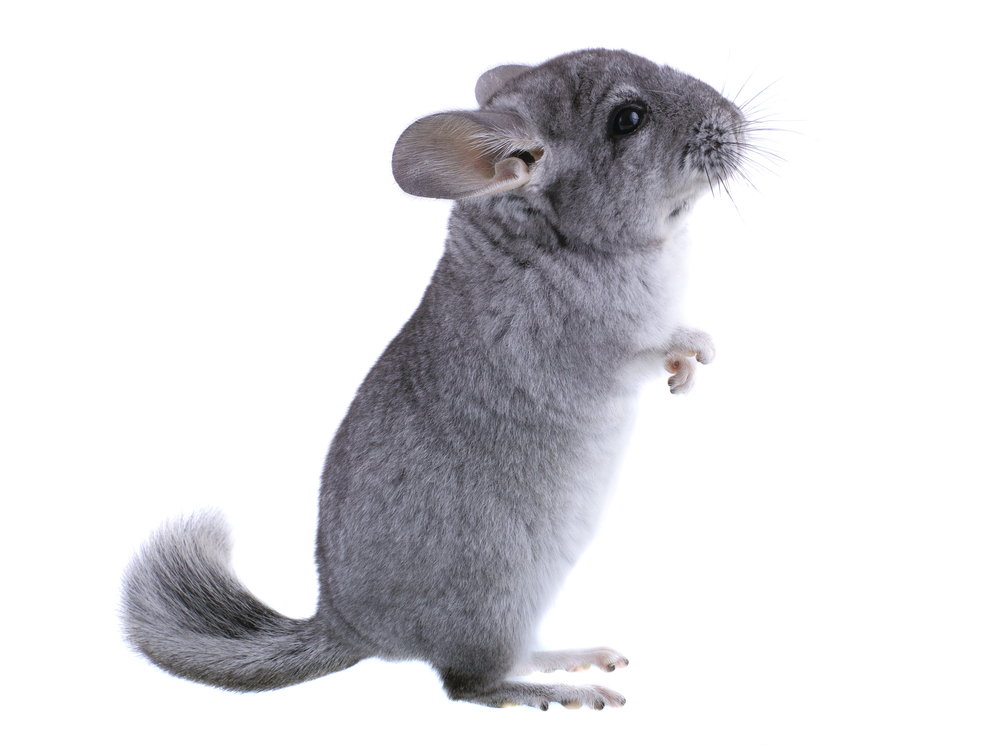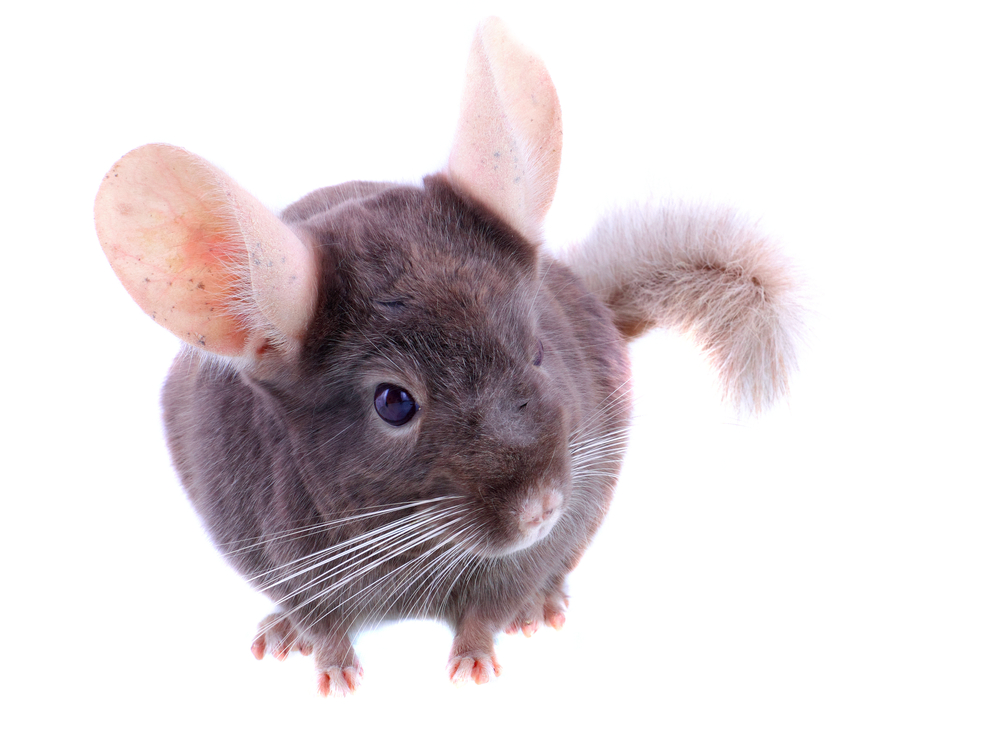Chinchilla Facts

Chinchillas are rodents that are native to the Andes Mountains of northern Chile. Often kept as pets, chinchillas are also prized for their luxuriously soft fur and were nearly driven to extinction because of the demand.
Chinchilla fur was originally mottled yellow-gray in the wild, according to The Merck Veterinary Manual. Through selective breeding, however, other colors have become common, including silver, yellow-gray, bluish-gray, white, beige and black. Each hair ends in a black tip, no matter what color the chinchillas are.
First appearing around 41 million years ago, the chinchilla's ancestors were some of the first rodents to infest South America. Chinchilla fur became popular in the 1700s, and the animals were hunted nearly to extinction by 1900. About that time, Argentina, Bolivia, Chile and Peru banned the hunting of wild chinchillas.
However, according to the Chinchilla Chronicles website, an American mining engineer named Mathias F. Chapman got special permission from the Chilean government to bring chinchillas to the United States in 1923. Nearly every pet chinchilla in the United States today is a direct descendant of 11 chinchillas that Chapman brought to the country.
Physical characteristics
Chinchillas are related to guinea pigs and porcupines. With short forelimbs and long, muscular hind legs, chinchillas resemble rabbits, but their ears are much shorter and rounder. They have large, black eyes and bushy tails. They have four toes on each foot, and the thin claws on each toe are surrounded by stiff bristles.
Chinchillas are typically 9 to 15 inches (23 to 38 centimeters) long, but the tail can add another 3 to 6 inches (8 to 15 cm) to their length. They generally weigh 1.1 to 1.8 lbs. (0.5 to 0.8 kilograms).
Habitat
Chinchillas are covered in thick fur for a reason. In the Andes, they can live in elevations of about 3,000 to 5,000 meters (9,800 to 16,400 feet). At those heights, it can be very cold — 23 degrees Fahrenheit (minus 5 degrees C) is the average minimum temperature in some places. Chinchillas can tolerate freezing temperatures, but they cannot survive in temperatures higher than 80 F (27 C); high temperatures and humidity can cause these rodents to suffer from heat stroke.
Chinchillas are crepuscular and nocturnal, which means they are very active at dawn or dusk and sleep during the day. They make their homes by burrowing in underground tunnels or nestling in rock crevasses. They are very social and live in colonies that consist of hundreds of chinchillas.
Females tend to be aggressive toward other females. When females are ready to mate, they can also be aggressive toward males, and are the dominant of the two genders. Females are mostly monogamous; they have only one mate throughout their lives. Males, on the other hand, can have many female mates. This is especially true of domesticated males. Often, one male is bred with many females to create many offspring to sell.

Offspring
The breeding season for chinchillas runs from November to May in the Northern Hemisphere and from May to November in the Southern Hemisphere.
Once a female chinchilla becomes pregnant, she will carry her young for about 111 days before giving birth. Females have babies twice a year. Each time they give birth, they will have one to six babies. These groups of babies are called litters. Individual babies are called kits.
Newborn kits are born with hair and with their eyes open. They weigh only 1.2 ounces (35 grams). The babies nurse for six to eight weeks, and when they're about 8 months old, the babies are ready to have offspring of their own. Generally, chinchillas live eight to 10 years, though some have lived as long as 20 years.
Diet
Chinchillas are omnivores; they eat both plants and meat. Primarily, they eat grass and seeds, but they also eat insects and bird eggs when they get the chance. To eat, they hold their food in their front paws and nibble on it.
Classification/taxonomy
There are two species of chinchillas: the long-tailed chinchilla and the short-tailed chinchilla. According to the Integrated Taxonomic Information System (ITIS), the taxonomy of chinchillas is:
- Kingdom: Animalia
- Phylum: Chordata
- Subphylum: Vertebrata
- Class: Mammalia
- Order: Rodentia
- Family: Chinchillidae
- Genus: Chinchilla
- Species: Chinchilla chinchilla (short-tailed chinchilla), Chinchilla lanigera (long-tailed chinchilla)
Conservation status
Though chinchilla fur is highly valued for use in clothing and coats, the Convention on International Trade in Endangered Species has restricted the sale and trade of wild chinchillas since 1975. Many chinchillas are bred commercially for their fur.
Both species of chinchilla are on the International Union for Conservation of Nature and Natural Resources' endangered-species list. Both the short-tailed chinchilla and the long-tailed chinchilla are listed as critically endangered. Short-tailed chinchillas are thought to be extinct in Bolivia and Peru but are suspected to be recovering in other areas. In 1996, there were only 42 colonies of long-tailed chinchillas, and the population has declined since then and continues to decline.
Pet chinchillas
The Michigan Humane Society recommends keeping domestic chinchillas in a wire mesh cage with a solid floor. The cage should be well ventilated and kept dry and cool in temperatures from 60 to 70 F (16 to 21 C). Chinchillas do not get along well when caged together, and should be kept in individual cages.
Chinchillas can eat food pellets available from pet stores, as well as hay, dried fruits and nuts, and carrots and green vegetables in moderation, or about 10 percent of their daily diet. A bottle equipped with a sipper tube is the best way to provide water.
To stay clean, these rodents give themselves dust baths. It is recommended that domestic chinchillas take dust baths once or twice per week in fine volcanic ash that can be purchased at pet shops.
Chinchillas are thought to be smarter than rabbits and can be taught to play with humans. They do not make good pets for small children, however, because chinchillas are hyperactive and high-strung.
Other resources
Sign up for the Live Science daily newsletter now
Get the world’s most fascinating discoveries delivered straight to your inbox.











